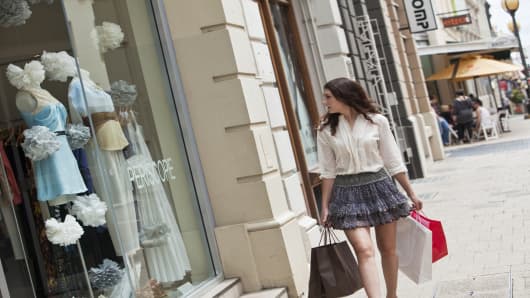Australian retail sales surged by the most in three years in February, blowing away expectations in the clearest sign yet that consumer demand is responding to lower interest rates.
The startling surprise lifted the local dollar and led investors to further lengthen the odds of any more cuts in interest rates this cycle.
"Clearly very strong, very surprising," was the reaction of Stephen Walters, chief economist at JPMorgan, the data.
"Near-term chances of a rate cut are very slim," he added. "I think the Reserve Bank has been looking for a few things -- one of them has been whether the household sector has been recovering and on this evidence they clearly are."
(Read More: Australia's Central Bank Chief Gets New Term)
The Reserve Bank of Australia (RBA) held rates steady at 3 percent at its April policy meeting this week in a show of confidence that 175 basis points of rate cuts since November 2011 were percolating through the economy.
Thursday's data from the Australian Bureau of Statistics showed retail sales surged 1.3 percent in February, far outstripping forecasts of a 0.3 percent increase. It was the largest monthly gain since November 2009 and followed an upwardly revised 1.2 percent rise in January.
The spending was also broad based, with every retail sector enjoying gains of over 1 percent for the month. Sales of household goods jumped 1.6 percent, clothing was up 1.2 percent, department stores 1.6 percent and eating out 1.3 percent.
The Australian dollar shot up as far as $1.0495 on the upbeat news but could not clear heavy options-related offers at $1.0500, a major chart level.
Interbank futures reversed course while swap rates showed the market pricing in around 15 basis points of rate cuts over the next 12 months, compared to 20 just before the data.
Buying and Building
The revival in sales is a boon for the economy as the A$260 billion ($265 billion) retail sector accounts for 17 percent of Australia's A$1.5 trillion in gross domestic product (GDP) and over 10 percent of all jobs.
A range of factors are supporting consumption including lower mortgage rates, widespread retail discounting, solid wage growth and a recovery in household wealth.
Consumers clearly have spending power if the demand for new cars is anything to go by. Industry figures out Thursday showed sales of new vehicles climbed 4.7 percent in March, from the month before, when adjusted for seasonal factors.
(Read More: Australia Trade Deficit Shrinks to 14-Month Low in February)
All this consuming will be welcomed by the RBA as it promises to plug any hole left when a long boom in mining investment starts to cool later this year.
Indeed, the news was doubly good as government data also showed a solid 3.1 percent increase in approvals to build new homes in February.
Housing accounts for only around 5 percent of GDP, but it is prone to large swings year to year. For instance, a typical recovery in home building can add anywhere from half to a full percentage point to economic growth.
"Traditionally, the building sector has led the economy," noted Matthew Johnson, an interest rate strategist at UBS.
"They expect mining is going to drop back a bit and that will make space for non-mining, and that is what we are seeing today. It supports the view that the RBA will be on hold for the rest of the year, which is the view we have."


